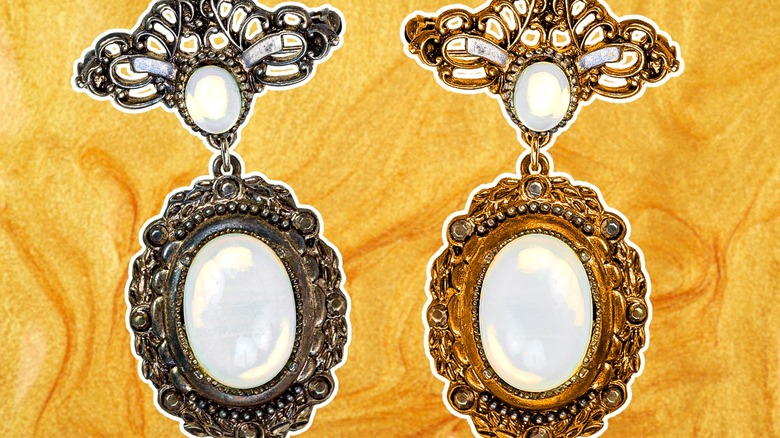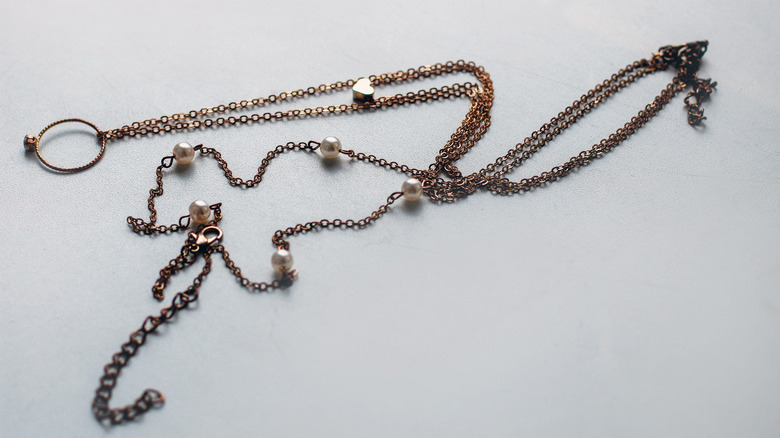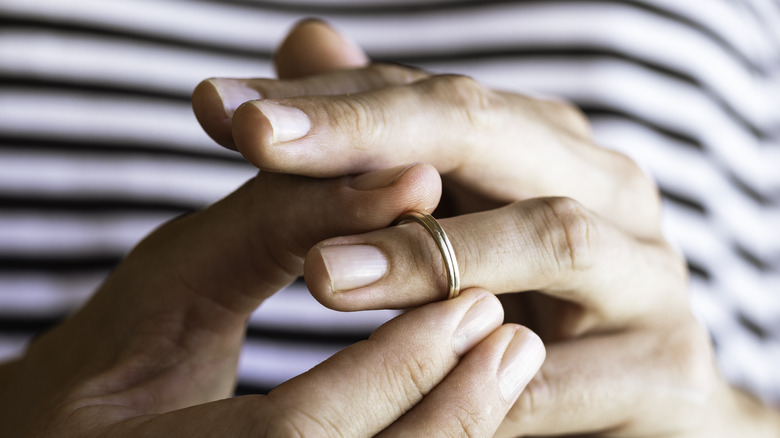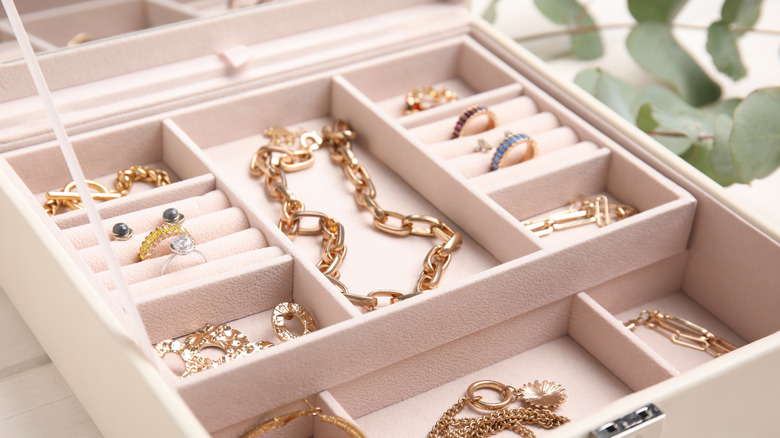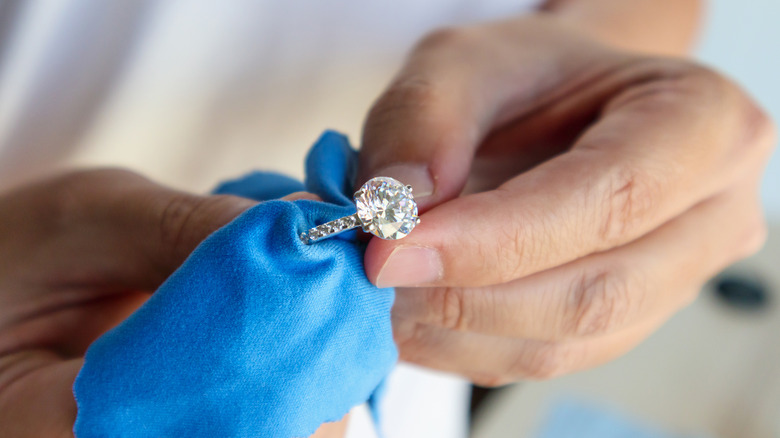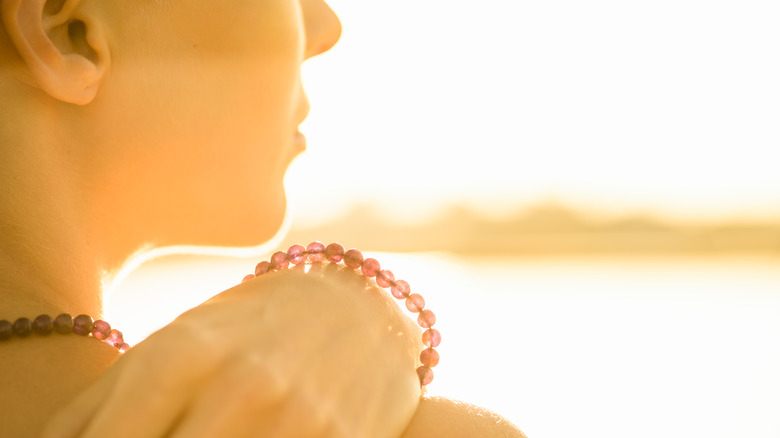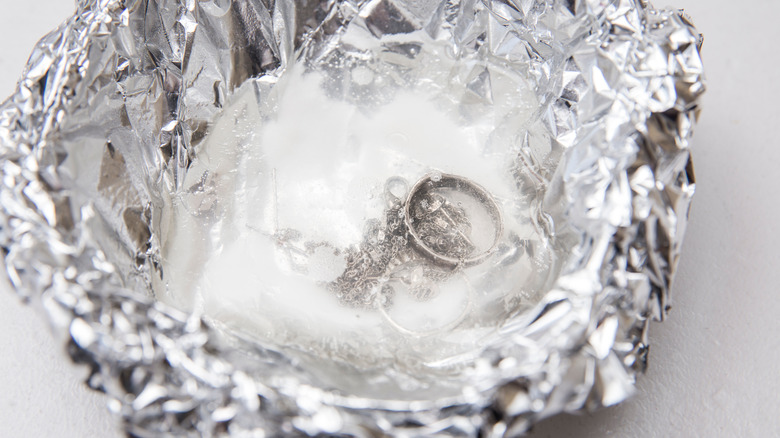What Causes Jewelry To Tarnish And How To Prevent It
We may receive a commission on purchases made from links.
If you wear jewelry every day, you may notice that some of your pieces lose their original shine. For example, your sparkling silver may turn into a lackluster gray or your bright copper may become a dull brown. This is called tarnishing, which happens when the original color and shine of a piece become duller or darker than when you first bought it.
Some metals are more prone to tarnishing than others. Jewelry made from pure metals like solid gold, silver, titanium, platinum, and aluminum will not tarnish, according to Specialty Metals. However, these are often the most expensive pieces, also known as fine jewelry. More affordable jewelry, known as fashion jewelry, is made of plated metals like nickel, brass, bronze, copper, iron, steel, sterling silver, and pewter, which are naturally prone to tarnishing when exposed to air and moisture over time (via Cooksongold). Don't worry though, tarnish doesn't mean your pieces are ruined forever. It can be removed, and there are some easy ways you can take care of your jewelry to prevent tarnish from happening in the first place.
What causes tarnish?
We often notice when our jewelry appears duller than usual, but we may not know the cause. Tarnishing occurs when metal reacts with other elements such as moisture, oils, acids, and oxygen (per Richard's Custom Jewelers). The discoloration is simply a reaction to the jewelry's environment. If we fail to clean and take care of our pieces, tarnishing is common.
According to Pure Impressions Design, even small amounts of sweat, lotion, or hairspray can cause tarnish and affect the appearance of jewelry. Improper storage, exposure to heat, and forgetting to clean your jewelry are some of the leading causes of jewelry tarnish. Tarnish may also occur if you forget to remove jewelry before showering or swimming. The good news is that tarnishing is completely preventable. Understanding why it happens can help you take better care of your jewelry and reduce the likelihood of tarnishing in the future.
Keep your jewelry dry
Moisture exposure is a common cause of jewelry tarnish. Your makeup, lotions, perfumes, and even sweat can wear down the metal over time. To prevent this, it's best to remove your jewelry when there's a chance of it getting wet, whether you're showering, bathing, exercising, or washing your hands (via Pure Impressions Design). Swimming with jewelry is also a big no-no, particularly in pools where chemicals can harm the metal. If your jewelry does accidentally get wet, dry it off and store it safely until you can wear it again.
Store your jewelry properly
Proper storage is another way to prevent your jewelry from tarnishing and keep it looking brand new. If you've been leaving your jewelry sitting on the dresser or bathroom counter, you may want to rethink how you store your jewelry. It's best to store your pieces in a closed jewelry box where each piece has its own space, according to Amanda Gizzi of Jewelers of America (via HuffPost). Velvet or cotton jewelry bags are also good options, but be sure to keep them separate to prevent pieces from scratching against each other.
Clean your jewelry often
Anything we wear is bound to get dirty over time, and jewelry is no exception. According to jewelry shop owner Don Brown, "The best thing you can do is wipe it with a soft cloth each day after wearing it," as he told Martha Stewart. A simple wipe can remove build-up and keep your jewelry sparkling and clean, taking only a few seconds.
Avoid long exposure to heat and sun
Excessive exposure to the sun can damage not only your skin but also your precious jewelry. Sunlight can fade the color of your jewelry and weaken its adhesives (via Little Switzerland). Although it's not a bad idea to wear jewelry outside for a short period of time, it's best to avoid wearing it all day in the sun. If you plan to spend a day at the beach, it's recommended to leave your jewelry at home to prevent damage.
Use jewelry protectant spray or polish
To provide extra protection for your jewelry, there are many anti-tarnish sprays and polishes available on the market that guard against tarnish and corrosion. These products dry quickly and are clear, keeping your jewelry sparkling for longer periods of time. Additionally, protective sprays can create a barrier between your skin and certain metals, which can be helpful for those with sensitive skin. We recommend trying Olive and Piper's Tarnish-Me-Not Hypoallergenic Jewelry Spray or the ProtectaClear protective coating.
How to remove tarnish at home
You can clean tarnished jewelry with items you probably already have in the house. The simplest solution is to use water and dish soap to clean the jewelry with a cloth, according to Good Housekeeping. Be sure to dry off the jewelry when you're done scrubbing. But if dish soap isn't quite cutting it, jewelry brand Swierenga Jewelers recommends some other at-home methods.
The first is mixing one part water and one part lemon juice and letting the jewelry soak for 10-15 minutes. The acid from the lemon juice can help lift some of the dirt and restore the original shine. Another effective method is to use baking soda, salt, and aluminum foil. Place the jewelry on a sheet of foil. Then, take one tablespoon of salt, and one tablespoon of baking soda, and mix them into a cup of warm water. Pour this mixture onto the jewelry, and it should create a bubbly reaction that cleans the jewelry.
If you're unsure about the type of metal or how valuable your piece is, consult a professional jeweler who can guide you. This is especially true if you're attempting to clean jewelry with softer gemstones, which have their own cleaning needs. You can also get your jewelry professionally cleaned if the tarnish doesn't seem to be coming off with your at-home methods.
